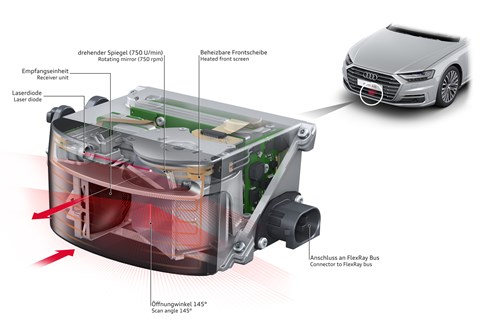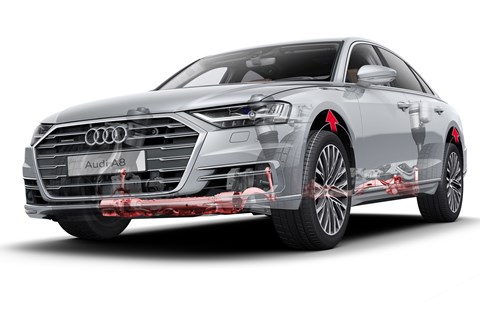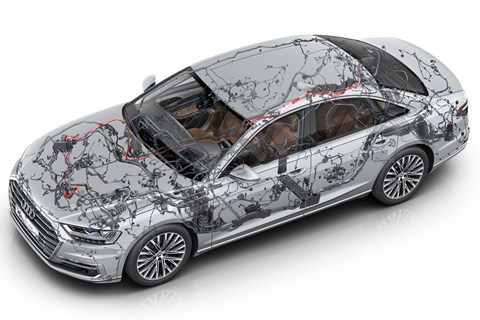► Audi A8 Level 3 tech
► ‘Game-changer’ in autonomy
► How did Audi make it?
Audi’s A8 limousine, on sale in the UK in late 2017, is a ‘game-changer’ for autonomous driving, one which takes autopilot capabilities to ‘the next level’. So claims Mirko Reuter, the company’s chief of piloted driving.
While Tesla cars can drive themselves for minutes on end at highway speeds and perform decisive overtakes, the bottom line is that the driver is still responsible for his or her safety and that of other road users. Not so in the A8.
‘In very certain circumstances you can hand over the driving task to the car itself, and the car drives itself and monitors everything itself,’ explains Reuter. ‘The driver can do something else while being driven in the car, for example, watch videos.’
Everything you need to know about the new Audi A8
This hands-off and eyes-off driving, Audi proclaims, is Level 3 autonomy. The company decries everything else on the market as Level 2, where driver assistance systems such as Active Cruise Control and Lane Departure Warning work together to propel the car.
‘With them, you’re always responsible,’ says Reuter. ‘That’s the difference with the A8, you hand over the driving task to the vehicle and the vehicle takes charge. Even if they call it piloted, it’s a driver assistance system.’
Sounds good. So what’s Audi’s special sauce?
No surprises that technology is crucial, with Audi claiming the world’s first automotive laser scanner to enhance the car’s vision. This is mounted in the lower grille beneath the registration plate, and provides a 145˚ viewing angle at a range of 80 metres. The laser beams (yes, frickin’ lasers, Austin Powers’ fans) are reflected back from objects up ahead in less than a millisecond and processed, to provide a picture of the environment in front.

The laser scanner is in addition to the essentials used by BMW, Volvo et al – radar, camera and multiple sensors, to monitor the zone around the car and road markings. Audi also credits an enormous amount of computing power in the ‘zFAS’ control board, which processes the data from all the autonomous systems and decides what the car should do. With all this kit to plumb in, it’s no surprise Audi needed a new electronic architecture, so rivals won’t be able to catch up overnight.
Moving to Level 3 autonomy and beyond requires a lot of systems backing up other systems just in case, or redundancy as the engineers call it. And Reuter lists a lot of redundancy, from the ‘seeing’ systems to the computer processing to the driving systems too: ‘for us we have two braking systems, and two power supplies in case one fails’.
Excellent, I look forward to being chauffeured to my door very soon…
Sadly the parameters in which you can use this system are extremely specific. Audi calls it Traffic Jam Pilot, which gives a big clue to when and where it can be used: in stop/go motorway congestion, at speeds of up to 60kmh (37mph). The system doesn’t have to worry about oncoming traffic as it’s on the other side of the Armco.

All the sensors and GPS positioning will enable the A8 to decide if the conditions are right for it to have a spin. The car will then alert the driver in the instrument binnacle, who then presses the Audi AI button ahead of the gear selector. Conversely, if the traffic speeds up, a series of chimes and visual warnings will hopefully coerce the driver into taking the wheel again – if not, the car will bring itself to a halt in lane.
Any other potential hitches?
With all the required technology, don’t expect Traffic Jam Pilot to be standard on the base A8, which will cost from 90,600 euros in Germany. But even if money is no object, there’s a whole Grand National of regulatory hurdles to clear before the self-piloting system is up and running.

In Europe, individual countries are responsible for legislating to allow self-driving vehicles, in the USA that duty falls to individual states. And in China, the government won’t even allow autonomous vehicle testing at this point. Even in Germany, which recently passed a law permitting autonomous driving, the A8’s tech still needs to be certified.
‘There are three challenges,’ signs off Reuter. ‘The legal framework needs to be in place for the country, homolgation needs to be fulfilled, and in every state and country, you need to do extensive testing and validation. All three need to be met for us to bring this to market starting 2018.’
We look forward to the A8’s launch – the first time a car manufacturer will be looking for congestion-clogged roads. If the UK makes good on its promise to pass autonomous legislation quickly, the M25 should be ideal.
Check out our Audi reviews right here